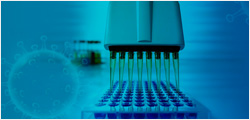-
REAGENT SERVICES
Hot!
-
Most Popular Services
-
Molecular Biology
-
Recombinant Antibody/Protein
-
Reagent Antibody
-
CRISPR Gene Editing
-
DNA Mutant Library
-
IVT RNA and LNP Formulations
-
Oligo Synthesis
-
Peptides
-
Cell Engineering
-
- CRISPR/Cas9 sgRNA
- CRISPR/Cas12a crRNA
- Prime Editing Guide RNA
- Base Editing Guide RNA
- HDR Templates
- gRNA + HDR Template Design Tools
- cGMP Guide RNA
- cGMP HDR Templates
- CRISPR/Cas Proteins
- CAR-T Knock-in Optimization Kit
- CRISPR Plasmids
- CRISPR gRNA Plasmid Libraries
- CRISPR Cell Lines
- Microbial Genome Editing
-
-
PRODUCTS
-
Most Popular Products
-
Antibodies
-
ELISA Kits
-
Protein Electrophoresis and Blotting
-
Protein and Antibody Purification
-
Recombinant Proteins
-
Molecular Biology
-
Stable Cell Lines
-
Cell Isolation and Activation
-
 IVD Raw Materials
IVD Raw Materials
-
 Therapy Applications
Therapy Applications
-
Online Shop
-
Resources
-
![AmMag™ Quatro Automated Plasmid Purification]() AmMag™ Quatro automated plasmid purification
AmMag™ Quatro automated plasmid purification
-
![Anti-Camelid VHH]() MonoRab™ Anti-VHH Antibodies
MonoRab™ Anti-VHH Antibodies
-
![Precast Gels]() SurePAGE™ Precast Gels
SurePAGE™ Precast Gels
-
![Quatro ProAb Automated Protein and Antibody Purification System]() AmMag™ Quatro ProAb Automated Protein and Antibody Purification System
AmMag™ Quatro ProAb Automated Protein and Antibody Purification System
-
![Target Proteins]() Target Proteins
Target Proteins
-
![AmMag™ Quatro Automated Plasmid Purification]() AmMag™ Quatro automated plasmid purification
AmMag™ Quatro automated plasmid purification
-
 IVD Raw Materials
IVD Raw Materials
-
![Quick
Order]() Quick Order
Quick Order
-
![Quick
Order]() Quick Order
Quick Order
- APPLICATIONS
- RESOURCES
- ABOUT US
- SIGN IN My Account SIGN OUT
- REGISTER
News & Blogs » Peptide News » α-Hemolysin derived from Staphylococcus aureus Promotes Inflammation Resolution through Generation of Specialized Pro-resolving Mediators
α-Hemolysin Derived from Staphylococcus Aureus Promotes Inflammation Resolution Through Generation of Specialized Pro-resolving Mediators
Host inflammatory response serves to eliminate pathogens and invading bacteria with the assistance of active defense mechanisms to limit and resolve inflammation. Pro-inflammatory lipid mediators (LMs) which include prostaglandins (PGs) and leukotrienes (LTs) are responsible for the initiation and maintenance of the inflammatory response. Specialized pro-resolving mediators (SPMs) are different from LMs in that they resolve inflammation, facilitating the host’s return to homeostasis. With the rise of multi-drug resistance, investigation of molecular mechanisms behind bacterial infections and their influence on resolution of inflammation through SPMs is critical.
Staphylococcus aureus is not only a major cause for sepsis, but carry a chronic disease pattern and high relapse rate. Though research has shown Escherichia coli to stimulate COX and LOX pathways in human macrophages eventually resulting in varied LM profiles in pheno-type-dependent matter, underlying factors for pathogenic bacterial induction of SPM generation in macrophages have been discovered. Several virulence factors including pore-forming toxins (PFTs) that can inhibit neutrophil chemotaxis or lyse neutrophils, block complement activation, and antimicrobial peptide neutralization are the major components of pathogenicity for S. aureus.
In addition to an increase in LM biosynthesis due to PFT secretion, the authors of this study demonstrated α-Hemolysin (Hla) may act as a powerful and selective activator of 15-LOX-1 in M2 macrophages. Despite the damaging effects of Hla on host cells, substantial SPM formation was induced and resulted in the promotion of inflammation resolution. Though Hla is an S. aureus-derived virulence factor, it increased activation of human 15-Lox-1 in human M2 macrophages resulting in increased SPM formation and no marked induction of PGs and LTs. Leading the orchestration for resolution of inflammation, SPMs are responsible for the induction of protective and repair pathways such as bacterial clearance, tissue repair, and enabling homeostasis return. LM extracted from Hla-stimulated M2 macrophages were found to accelerate head regeneration of planarians in vivo. It is also possible additional SPMs or SPM precursors may interact synergistically with LM isolated to promote head regeneration. Hla administration to mice resulted in elevated SPMs and 12 15-Lox products, but exhibited limited production of pro-inflammatory components such as LTs, TNF-alpha, IL-1B, IL-6, and neutrophil recruitment. Although resident PMs may be primarily responsible for LM production upon HLA entrance in mice, neutrophils, monophils, and epithelial cells may also be a prominent contributor to increased production of PMs.
Secreted factors from S. aureus, including LM production in M2 macrophages, were found to induce upregulation through robust activation 15-LOX-1 through a biosynthetic key enzyme. Stimuli that were able to evoke cellular formation of LOX products needed steady supply of free fatty acid substrates and LOX translocation for membranous compartments. These process are both established in macrophages through Ca2+ elevating agents such as ionophores, GPCR ligands, thapsigargin, ATP or zymosan, but only marginally evoked SPM production. Hla was found to typically increase Ca2+ in many cell types with subsequent consequences such as increased amino acid release. In M2 macrophages, isolated Hla or SACM led to increased concentration of Ca2+, and respective Ca2+ depletion studies confirmed the necessitation of Ca+ for Hla-evoked LM biosynthesis. When binding to host cell membrane, Hla will assemble into a heptameric complex that perforates plasma to achieve a Ca2+ influx with the assistance of protein receptor ADAM10. ADAM10, a metalloprotease, is expressed on surface of several host cells including monocytes/macrophages and neutrophils, with activation induced by Ca2+ influx. The data in this study also demonstrated ADAM10’s selective role of HLA-induced 15-LOX-1 activation and SPM formation.
Through the selective activation of 15-LOX-1 pathways, Hla was identified as an S. aureus-derived PFT with a remarkable capability of eliciting substantial SPM formation in human and murine macrophages. The results of this study may suggest exploitation of Hla as a PFT for eliciting SPM formation as a treatment for S. aureus infections.
Reference
- Jordan, G. (2020). Staphylococcus aureus-Derived α-Hemolysin Evokes Generation of Specialized Pro-resolving Mediators Promoting Inflammation Resolution. Cell Reports (Cambridge), 33(2), 108247–108247.
Subscribe to Receive Updates
& Promotions From GenScript* We'll never share your email address with a third-party.
Latest News & Blogs
Find More Peptide NewsUnveiling the Potential of GLP-1 Receptor Agonists and Multi-Target Therapies

Challenges in Neoantigen Peptide Manufacturing | GenScript

Challenges & Innovations in Neoantigen Peptide Vaccine Production

The Clinical Application of Neoantigens: A Promising Frontier in Cancer Immunotherapy

Delving into the World of Cyclic Peptides: Harnessing the Power of Circular Molecules for Innovative Therapeutic Solutions

Ensure Safe & Effective Peptide Drugs: Mastering GMP Compliance for Quality Control


-



































